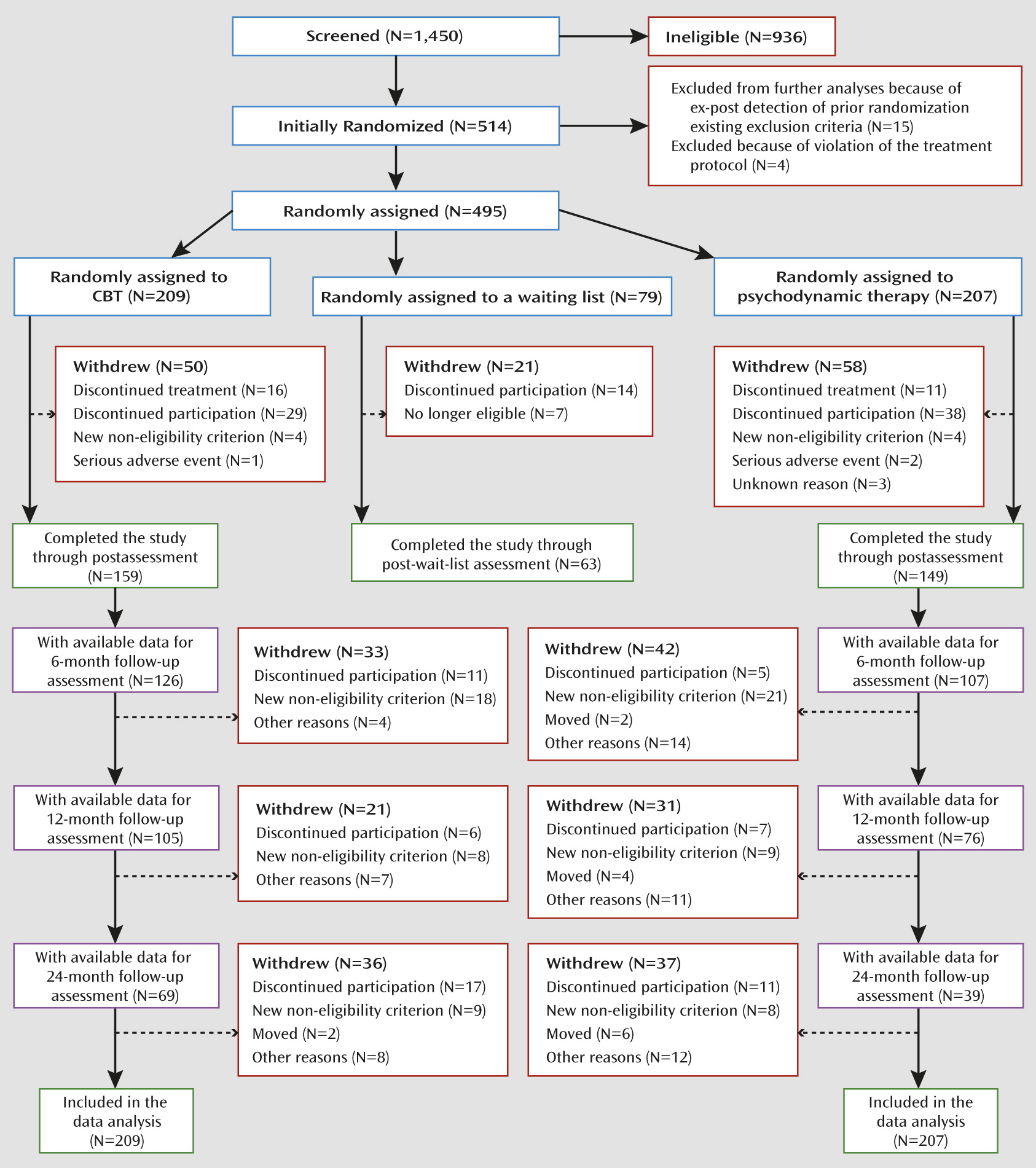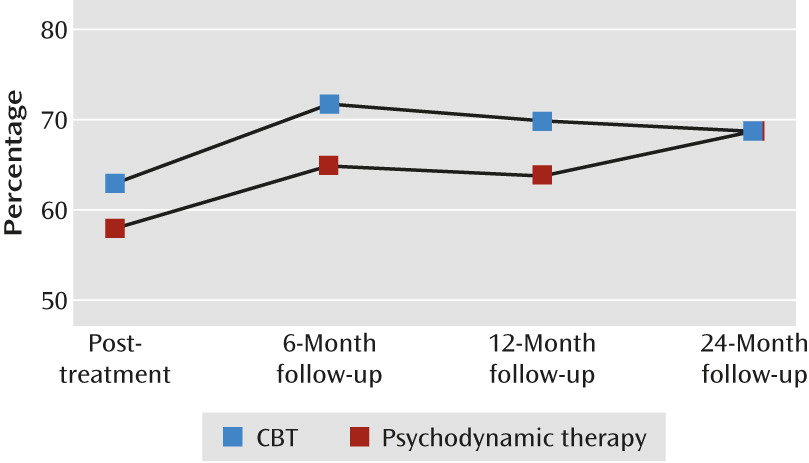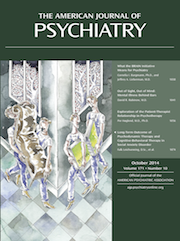Long-Term Outcome of Psychodynamic Therapy and Cognitive-Behavioral Therapy in Social Anxiety Disorder
Abstract
Objective
Method
Results
Conclusions
Method
Study Design and Implementation
Study Participants
Treatments
Therapists
Assessment and Masking
Randomization
Statistical Analyses
Results
Patient Flow
| Study Center and Characteristic | Cognitive-Behavioral Therapy Group (N=209) | Psychodynamic Therapy Group (N=207) | All Participants (N=495)a | |||
|---|---|---|---|---|---|---|
| N | % | N | % | N | % | |
| University of Bochum | 44 | 50.0 | 29 | 33.0 | 88 | 17.8 |
| University of Göttingen | 37 | 43.0 | 33 | 38.4 | 86 | 17.4 |
| University of Dresden | 45 | 41.3 | 46 | 42.2 | 109 | 22.0 |
| University of Jena | 40 | 36.7 | 52 | 47.7 | 109 | 22.0 |
| University of Mainz | 43 | 41.8 | 47 | 45.6 | 103 | 20.8 |
| Mean | SD | Mean | SD | Mean | SD | |
| Age (years) | 34.85 | 12.03 | 34.37 | 12.12 | 35.23 | 12.18 |
| Female sex | 113 | 54.1 | 111 | 53.7 | 270 | 54.6 |

Intercurrent treatments.
Outcome
| Outcome, Assessment Scale, and Time of Evaluation | CBT Group (N=209) | Psychodynamic Therapy Group (N=207) | ||||
|---|---|---|---|---|---|---|
| % | 95% CI | % | 95% CI | |||
| Remittedb | ||||||
| Posttherapy | 38 | 30–45 | 28 | 21–35 | ||
| Six-month follow-up | 44 | 34–53 | 37 | 27–46 | ||
| Twelve-month follow-up | 44 | 32–55 | 37 | 25–48 | ||
| Twenty-four-month follow-up | 39 | 25–42 | 38 | 22–54 | ||
| Respondedc | ||||||
| Posttherapy | 63 | 55–71 | 58 | 49–67 | ||
| Six-month follow-up | 72 | 62–81 | 65 | 55–75 | ||
| Twelve-month follow-up | 70 | 58–82 | 64 | 52–76 | ||
| Twenty-four-month follow-up | 69 | 53–84 | 69 | 54–84 | ||
| Mean | SD | 95% CI | Mean | SD | 95% CI | |
| Liebowitz Social Anxiety Scale scored | ||||||
| Baseline | 72.06 | 22.39 | 20.43–24.77 | 73.26 | 22.18 | 20.23–24.55 |
| Posttherapy | 41.43 | 35.00 | 36.65–46.21 | 46.70 | 36.84 | 41.64–51.76 |
| Six-month follow-up | 38.08 | 43.30 | 32.16–44.00 | 42.94 | 43.91 | 36.91–48.97 |
| Twelve-month follow-up | 38.28 | 54.10 | 30.88–45.67 | 42.69 | 58.09 | 34.71–50.67 |
| Twenty-four-month follow-up | 39.14 | 63.86 | 30.41–47.87 | 40.16 | 72.27 | 30.23–50.09 |
| Social Phobia and Anxiety Inventory scoree | ||||||
| Baseline | 90.05 | 19.17 | 87.43–92.67 | 90.40 | 19.11 | 87.77–93.02 |
| Posttherapy | 64.48 | 31.55 | 60.16–68.79 | 73.18 | 28.68 | 69.24–77.12 |
| Six-month follow-up | 62.51 | 34.55 | 57.79–67.24 | 68.10 | 33.47 | 63.50–72.70 |
| Twelve-month follow-up | 63.52 | 35.88 | 58.61–68.42 | 67.28 | 39.16 | 61.90–72.66 |
| Twenty-four-month follow-up | 64.85 | 40.56 | 59.30–70.39 | 66.39 | 46.08 | 60.06–72.72 |
| Beck Depression Inventory scoref | ||||||
| Baseline | 14.44 | 8.83 | 13.24–15.65 | 13.70 | 9.57 | 12.38–15.01 |
| Posttherapy | 8.27 | 8.35 | 7.13–9.41 | 9.80 | 9.35 | 8.51–11.08 |
| Six-month follow-up | 8.12 | 9.19 | 6.87–9.38 | 9.27 | 9.50 | 7.96–10.57 |
| Twelve-month follow-up | 8.20 | 9.34 | 6.93–9.48 | 8.82 | 9.16 | 7.57–10.08 |
| Twenty-four-month follow-up | 8.52 | 9.11 | 7.27–9.76 | 9.46 | 10.97 | 7.95–10.96 |
| Inventory of Interpersonal Problems scoreg | ||||||
| Baseline | 14.27 | 3.77 | 13.75–14.78 | 14.02 | 3.91 | 13.48–14.56 |
| Posttherapy | 10.94 | 5.36 | 10.21–11.67 | 12.29 | 5.56 | 11.53–13.06 |
| Six-month follow-up | 10.32 | 6.34 | 9.46–11.19 | 11.05 | 6.01 | 10.22–11.87 |
| Twelve-month follow-up | 10.21 | 6.21 | 9.36–11.06 | 10.82 | 6.35 | 9.95–11.69 |
| Twenty-four-month follow-up | 10.58 | 6.57 | 9.68–11.48 | 10.65 | 7.18 | 9.67–11.64 |


Discussion
Acknowledgments
Footnote
Supplementary Material
- View/Download
- 124.31 KB
References
Information & Authors
Information
Published In
History
Authors
Funding Information
Metrics & Citations
Metrics
Citations
Export Citations
If you have the appropriate software installed, you can download article citation data to the citation manager of your choice. Simply select your manager software from the list below and click Download.
For more information or tips please see 'Downloading to a citation manager' in the Help menu.
View Options
View options
PDF/EPUB
View PDF/EPUBLogin options
Already a subscriber? Access your subscription through your login credentials or your institution for full access to this article.
Personal login Institutional Login Open Athens loginNot a subscriber?
PsychiatryOnline subscription options offer access to the DSM-5-TR® library, books, journals, CME, and patient resources. This all-in-one virtual library provides psychiatrists and mental health professionals with key resources for diagnosis, treatment, research, and professional development.
Need more help? PsychiatryOnline Customer Service may be reached by emailing [email protected] or by calling 800-368-5777 (in the U.S.) or 703-907-7322 (outside the U.S.).

